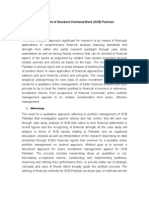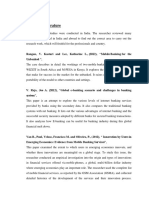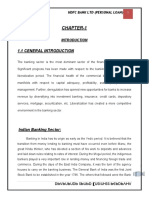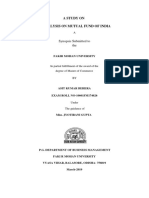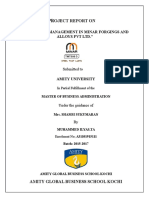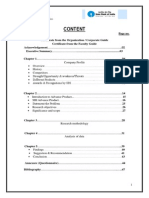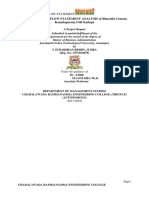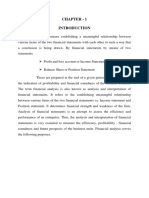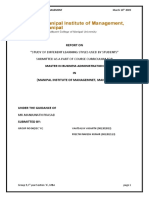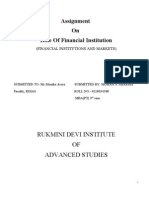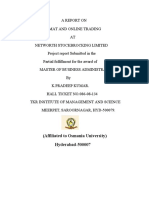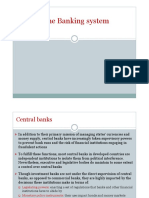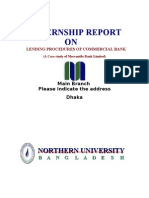Introduction of Banking Sector
Introduction of Banking Sector
Uploaded by
Patel BinnyCopyright:
Available Formats
Introduction of Banking Sector
Introduction of Banking Sector
Uploaded by
Patel BinnyCopyright
Available Formats
Share this document
Did you find this document useful?
Is this content inappropriate?
Copyright:
Available Formats
Introduction of Banking Sector
Introduction of Banking Sector
Uploaded by
Patel BinnyCopyright:
Available Formats
Introduction Of Banking Sector GENERAL INTRODUCTION ABOUT THE SECTOR The Indian economy is emerging as one of the strongest
economy of the world with the GDP growth of more than 8% every year. This has given a great support for the development of banking industry in the country. Due to globalization, competition among the banks has drastically been increased. As India has a substantial upper and middle class income hence the banks have immense opportunities to increase their market shares. The consumer being on the receiving end is in the comfortable position but the banks trying to increase their market share have to continuously add value for consumers in order to increase market share and sustain their growth. BANKING SECTOR The banking sector is the most dominant sector of the financial system in India. Significant progress has been made with respect to the banking sector in the post liberalization period. The financial health of the commercial banks has improved manifolds with respect to capital adequacy, profitability, and asset quality and risk management. Further, deregulation has opened new opportunities for banks to increase revenue by diversifying into investment banking, insurance, credit cards, depository services, mortgage, securitization, etc. Liberalization has created a more competitive environment in the banking sector INDUSTRY PROFILE a) ORIGIN AND DEVELOPMENT OF THE INDUSTRY The origin of banking in India is traceable in ancient time through the modern banking hardly 200 years old. The main function of bank is to accept deposits and grant loans. There is evidence of these functions being performed by a section of the community in the Vedic periods. There are many references of debt in the Vedic literature. During the Ramayana and Mahabharata areas banking, which was a side business during the Vedic period, become a fulltime business activity for the people. During the smriti period, which followed the Vedic period and the Epic age, bankers performed the...
Introduction of banking sector 1.1) The Bank The word bank means an organization where people and business can invest or borrowmoney; change it to foreign currency etc. According to Halsbury A Banker is anindividual, Partnership or Corporation whose sole pre-dominant business is banking, that isthe receipt of money on current or deposit account, and the payment of cheque drawn andthe collection of cheque paid in by a customer. 1.2) The Origin and Use of Banks The Word Bank is derived from the Italian word Banko signifying a bench, which waserected in the market-place, where it was customary to exchange money. The LombardJews were the first to practice this exchange business, the first bench having beenestablished in Italy A.D. 808. Some authorities assert that the Lombard merchantscommenced the business of money-dealing, employing bills of exchange as remittances,about the beginning of the thirteenth century.About the middle of the twelfth century it became evident, as the advantage of coinedmoney was gradually acknowledged, that there must be some controlling power, somecorporation which would undertake to keep the coins that were to bear the royal stamp up toa certain standard of value; as, independently of the sweating which invention may placeto the credit of the ingenuity of the Lombard merchants- all coins will, by wear or abrasion, become thinner, and consequently less valuable; and it is of the last importance, not only for the credit of a country, but for the easier regulation of commercial transactions, that themetallic currency be kept as nearly as possible up to the legal standard. Much unnecessarytrouble and annoyance has been caused formerly by negligence in this respect. The gradualmerging of the business of a goldsmith into a bank appears to have been the way in which banking, as we now understand the term, was introduced into England; and it was not untillong after the establishment of banks in other countries-for state purposes, the regulation of the coinage, etc. that any large or similar institution was introduced into England. It is onlywithin the last twenty years that printed cheques have been in use in that establishment. First commercial bank was Bank of Venice which was established in 1157 in Italy.
1.3) THE BANKING REFORMS In 1991, the Indian economy went through a process of economic liberalization, which wasfollowed up by the initiation of fundamental reforms in the banking sector in 1992. The banking reform package was based on the recommendations proposed by the NarasimhamCommittee Report (1991) that advocated a move to a more market oriented banking system,which would operate in an environment of prudential regulation and transparent accounting.One of the primary motives behind this drive was to introduce an element of marketdiscipline into the regulatory process that would reinforce the supervisory effort of theReserve Bank of India (RBI). Market discipline, especially in the financial liberalization phase, reinforces regulatory and supervisory efforts and provides a strong incentive to banksto conduct their business in a prudent and efficient manner and to maintain adequate capitalas a cushion against risk exposures. Recognizing that the success of economic reforms wascontingent on the success of financial sector reform as well, the government initiated afundamental banking sector reform package in 1992.Banking sector, the world over, is known for the adoption of multidimensional strategiesfrom time to time with varying degrees of success. Banks are very important for the smoothfunctioning of financial markets as they serve as repositories of vital financial informationand can potentially alleviate the problems created by information asymmetries. From acentral banks perspective, such high-quality disclosures help the early detection of problems faced by banks in the market and reduce the severity of market disruptions.Consequently, the RBI as part and parcel of the financial sector deregulation, attempted toenhance the transparency of the annual reports of Indian banks by, among other things,introducing stricter income recognition and asset classification rules, enhancing the capitaladequacy norms, and by requiring a number of additional disclosures sought by investors tomake better cash flow and risk assessments.During the pre economic reforms period, commercial banks & development financialinstitutions were functioning distinctly, the former specializing in short & medium termfinancing, while the latter on long term lending & project financing. Commercial bankswere accessing short term low cost funds thru savings investments like current accounts,savings bank accounts & short duration fixed deposits, besides collection float.Development Financial Institutions (DFIs) on the other hand,were essentially depending on budget allocations for long term lending at a concessionary rate of interest. The scenario haschanged radically during the post reforms period, with the resolve of the government not tofund the DFIs through budget allocations. DFIs like IDBI, IFCI & ICICI had posted dismalfinancial results. Infect, their very viability has become a question mark. Now, they havetaken the route of reverse
merger with IDBI bank & ICICI bank thus converting them intothe universal banking system.
2.1) AXIS Bank Axis Bank was the first of the new private banks to have begun operations in 1994, after theGovernment of India allowed new private banks to be established. The Bank was promoted jointly by the Administrator of the specified undertaking of the Unit Trust of India (UTI - I),Life Insurance Corporation of India (LIC) and General Insurance Corporation of India(GIC) and other four PSU insurance companies, i.e. National Insurance Company Ltd., The New India Assurance Company Ltd., The Oriental Insurance Company Ltd. and UnitedIndia Insurance Company Ltd.The Bank today is capitalized to the extent of Rs. 401.95 crore with the public holding(other than promoters) at 53.23%.The Bank's Registered Office is at Ahmedabad and its Central Office is located at Mumbai.The Bank has a very wide network of more than 905 branches and Extension Counters (ason 30th September 2009). The Bank has a network of over 3894 ATMs (as on 30thSeptember 2009) providing 24 hrs a day banking convenience to its customers. This is oneof the largest ATM networks in the country.The Bank has strengths in both retail and corporate banking and is committed to adoptingthe best industry practices internationally in order to achieve excellence.
Mission
Customer Service and Product Innovation tuned to diverse needs of individual andcorporate clientele.
Continuous technology up gradation while maintaining human values.
Progressive globalization and achieving international standards.
Efficiency and effectiveness built on ethical practices. Core Values
Customer Satisfaction through providing quality service effectively and efficiently.
"Smile, it enhances your face value" is a service quality stressed on Periodic Customer Service.
Audits Maximization of Stakeholder value Success through Teamwork, Integrity andPeople.
2) BANK OF INDIA Bank of India was founded on 7th September, 1906 by a group of eminent businessmenfrom Mumbai. The Bank was under private ownership and control till July 1969 when itwas nationalized along with 13 other banks.Beginning with one office in Mumbai, with a paid-up capital of Rs.50 lakh and 50employees, the Bank has made a rapid growth over the years and blossomed into a mightyinstitution with a strong national presence and sizable international operations. In businessvolume, the Bank occupies a premier position among the nationalised banks.The Bank has 3101 branches in India spread over all states/
union territories including 141specialized branches. These branches are controlled through 48 Zonal Offices . There are 29 branches/ offices (including three representative offices) abroad.The Bank came out with its maiden public issue in 1997 and follow on QualifiedInstitutions Placement in February 2008. . Total number of shareholders as on 30/09/2009 isRs. 2,15,790.While firmly adhering to a policy of prudence and caution, the Bank has been in theforefront of introducing various innovative services and systems. Business has beenconducted with the successful blend of traditional values and ethics and the most moderninfrastructure. The Bank has been the first among the nationalized banks to establish a fullycomputerized branch and ATM facility at the Mahalaxmi Branch at Mumbai way back in1989. The Bank is also a Founder Member of SWIFT in India. It pioneered the introductionof the Health Code System in 1982, for evaluating/ rating its credit portfolio.The Bank's association with the capital market goes back to 1921 when it entered into anagreement with the Bombay Stock Exchange (BSE) to manage the BSE Clearing House. Itis an association that has blossomed into a joint venture with BSE, called the BOIShareholding Ltd. to extend depository services to the stock broking community. Bank of India was the first Indian Bank to open a branch outside the country, at London, in 1946,and also the first to open a branch in Europe, Paris in 1974. The Bank has sizable presenceabroad, with a network of 29 branches (including five representative offices) at key bankingand financial centers viz. London, Newyork, Paris, Tokyo, Hong-Kong and Singapore. Theinternational business accounts for around 17.82% of Bank's total business. Mission "To provide superior, proactive banking services to niche markets globally, while providingcost-effective, responsive services to others in our role as a development bank, and in sodoing, meet the requirements of our stakeholders". Vision "To become the bank of choice for corporate, medium businesses and up market retailcustomers and to provide cost effective developmental banking for small business, massmarket and rural markets
You might also like
- A CompleteDayTradingSystem FiguresDocument130 pagesA CompleteDayTradingSystem Figurescreationinstant33100% (1)
- Options Trading Advanced ModuleDocument110 pagesOptions Trading Advanced ModuleRam Kumar100% (6)
- Crypto Project Final Report - 1Document49 pagesCrypto Project Final Report - 1Deepak GowdaNo ratings yet
- Portfolio Management of Standard Chartered BankDocument4 pagesPortfolio Management of Standard Chartered BankFaìxan MunìrNo ratings yet
- G. Mannarino - Ultimate Guide To Money and The MarketsDocument197 pagesG. Mannarino - Ultimate Guide To Money and The MarketsD.C.75% (4)
- Dawn Bolton-Smith (2001) - On Trading Systems (5 P.)Document5 pagesDawn Bolton-Smith (2001) - On Trading Systems (5 P.)Frank100% (1)
- FINN 400-Applied Corporate Finance-Fazal Jawad Sayyed PDFDocument6 pagesFINN 400-Applied Corporate Finance-Fazal Jawad Sayyed PDFAhmed RazaNo ratings yet
- Chapter - 1Document32 pagesChapter - 1raj tripathiNo ratings yet
- Mutual FundDocument53 pagesMutual FundBhavesh PatelNo ratings yet
- Mis Report: A Project Report OnDocument107 pagesMis Report: A Project Report OnAbhishek VichhiNo ratings yet
- 03 Literature ReviewDocument15 pages03 Literature ReviewPraveen PuliNo ratings yet
- Project Report On Personal Loan CompressDocument62 pagesProject Report On Personal Loan CompressSudhakar GuntukaNo ratings yet
- A Study On An Analysis On Mutual Fund of India: Synopsis Submitted To TheDocument10 pagesA Study On An Analysis On Mutual Fund of India: Synopsis Submitted To TheAsit kumar BeheraNo ratings yet
- Portfolio Management in Idbi Federal Training ReportDocument49 pagesPortfolio Management in Idbi Federal Training ReportAshu Agarwal67% (6)
- Indian Automobile Industry PDFDocument28 pagesIndian Automobile Industry PDFAbel JohnNo ratings yet
- ILYASD (1) (Repaired)Document67 pagesILYASD (1) (Repaired)ilyasNo ratings yet
- XXXXX MFDocument24 pagesXXXXX MFpratik0909No ratings yet
- Aurobindo PharmaceuticalsDocument7 pagesAurobindo Pharmaceuticalsitsvijay100% (1)
- Project Report On e BankingDocument216 pagesProject Report On e BankingSanjay TripathiNo ratings yet
- Project On Impact of Dividends PolicyDocument45 pagesProject On Impact of Dividends Policyarjunmba119624100% (1)
- Synopsis of Derivative ProjectDocument11 pagesSynopsis of Derivative ProjectSHAIK YASINNo ratings yet
- Equitas Holding FinalDocument9 pagesEquitas Holding FinalRajat NidoniNo ratings yet
- Ankit Project Report of EmsopDocument50 pagesAnkit Project Report of EmsopAnkit JainNo ratings yet
- Project On LoanDocument53 pagesProject On LoanShikha TrehanNo ratings yet
- The Impact of Social Networking Sites On College Students' Consumption PatternsDocument39 pagesThe Impact of Social Networking Sites On College Students' Consumption PatternsAvinash MishraNo ratings yet
- Darshan PPT 1Document42 pagesDarshan PPT 1Sudarshan Reddy YNo ratings yet
- ProjectDocument79 pagesProjectRanjith KumarNo ratings yet
- Bankruptcy UsecaseDocument16 pagesBankruptcy UsecaseRiya KumarNo ratings yet
- Impact of Cultural Disparities On Food Chains InternationallyDocument75 pagesImpact of Cultural Disparities On Food Chains InternationallyAyush SharmaNo ratings yet
- Asset Liability Management ICICIDocument75 pagesAsset Liability Management ICICISanthosh Soma100% (1)
- Report On: "Study of Different Learning Styles Used by Students" Submitted As A Part of Course Curriculum ForDocument19 pagesReport On: "Study of Different Learning Styles Used by Students" Submitted As A Part of Course Curriculum ForgashwinjainNo ratings yet
- The Role of Commercial Banks Funding On The Development of SmallDocument11 pagesThe Role of Commercial Banks Funding On The Development of Smallbhanu matiNo ratings yet
- Perception 2Document59 pagesPerception 2harshNo ratings yet
- Working Capital Management India InfolineDocument83 pagesWorking Capital Management India Infolinearjunmba119624100% (1)
- Consumer Buying Behaviour Toward LG's Oven inDocument48 pagesConsumer Buying Behaviour Toward LG's Oven inSanju Gohil0% (1)
- Summer Training Report: Cost Reduction or Increase in Revenue of Punjab National BankDocument46 pagesSummer Training Report: Cost Reduction or Increase in Revenue of Punjab National BankDeepu SinghNo ratings yet
- Kalyana Lakshmi SchemeDocument9 pagesKalyana Lakshmi SchemeMubeen100% (4)
- The Role of Financial Institutions in Long Run Economic GrowthDocument12 pagesThe Role of Financial Institutions in Long Run Economic GrowthPrateek GaurNo ratings yet
- PREET 2nd Project FinalDocument73 pagesPREET 2nd Project Final308 Kiranjeet KaurNo ratings yet
- Certificate: A Project Report On "Retail Banking"Document27 pagesCertificate: A Project Report On "Retail Banking"Parag MogarkarNo ratings yet
- Project Report On Indian Banking SystemDocument54 pagesProject Report On Indian Banking SystemParth prajapatiNo ratings yet
- A Project Report On "PERFORMANCE ANALYSIS OF MUTUAL FUND TAX SAVINGS SCHEME IN INDIADocument45 pagesA Project Report On "PERFORMANCE ANALYSIS OF MUTUAL FUND TAX SAVINGS SCHEME IN INDIAKiran AryaNo ratings yet
- Indian Pharmaceutical IndustryDocument9 pagesIndian Pharmaceutical IndustryAshish GondaneNo ratings yet
- Banking System Black BookDocument39 pagesBanking System Black BookhaddyNo ratings yet
- Role Ambiguity and Role Conflict Within Interdependent TeamsDocument25 pagesRole Ambiguity and Role Conflict Within Interdependent TeamsBilal AhmedNo ratings yet
- A Study On Financial Risk and Event Analysis of Scorpio Events Pvt. LTDDocument63 pagesA Study On Financial Risk and Event Analysis of Scorpio Events Pvt. LTDAditya DeshakNo ratings yet
- Kotak Mahindra BankDocument9 pagesKotak Mahindra BankPrajwal KaDwad100% (1)
- Sravanya MTDocument60 pagesSravanya MTPUTTU GURU PRASAD SENGUNTHA MUDALIAR100% (8)
- Performance Appraisal 2018Document81 pagesPerformance Appraisal 2018maria mercyNo ratings yet
- Gold-As Investment Perspective: Dissertation Project Report On " "Document4 pagesGold-As Investment Perspective: Dissertation Project Report On " "Berkshire Hathway coldNo ratings yet
- Final Report of Vijaya Bank Part 2Document49 pagesFinal Report of Vijaya Bank Part 2shivangi shawNo ratings yet
- Financial Performance of Icici Bank LTDDocument116 pagesFinancial Performance of Icici Bank LTDRicardo Nitish KumarNo ratings yet
- Financial Management - HDFCDocument7 pagesFinancial Management - HDFCmohammed khayyumNo ratings yet
- Impact of Mergers & Acquisition On Banking IndustryDocument15 pagesImpact of Mergers & Acquisition On Banking IndustryJim WickNo ratings yet
- Comparative Study On Housing Loans in India FinanceDocument4 pagesComparative Study On Housing Loans in India FinanceNaresh HariyaniNo ratings yet
- Financial Performance Analysis of Selected Indian IT Companies by Using DuPont Model PDFDocument26 pagesFinancial Performance Analysis of Selected Indian IT Companies by Using DuPont Model PDFTapesh SharmaNo ratings yet
- CRM at Big BazaarDocument66 pagesCRM at Big BazaarSKSAIDINESHNo ratings yet
- Pradeep ProjectDocument66 pagesPradeep Project9908107924No ratings yet
- Comparative Study in Equity Schemes of Various Companies Mutual FundDocument82 pagesComparative Study in Equity Schemes of Various Companies Mutual FundJayesh PatelNo ratings yet
- Dissertation Project On Mutual FundsDocument66 pagesDissertation Project On Mutual FundsHarsh Vardhan100% (1)
- Research ReportDocument66 pagesResearch ReportSuraj DubeyNo ratings yet
- Project Report On Personal Loan CompressDocument62 pagesProject Report On Personal Loan CompressSudhakar GuntukaNo ratings yet
- A Synopsis Report ON AT Icici Bank LTD: Dividend DecisionDocument10 pagesA Synopsis Report ON AT Icici Bank LTD: Dividend DecisionMOHAMMED KHAYYUMNo ratings yet
- ICICI Bank - Working Capital Management - AmityDocument75 pagesICICI Bank - Working Capital Management - AmityShalabh ChauhanNo ratings yet
- rev mba int repDocument45 pagesrev mba int repabrariqbal32No ratings yet
- Financial Markets and InstrumentsDocument5 pagesFinancial Markets and Instrumentsedmund MallinguhNo ratings yet
- Risk Analysis For Corporate Bond PortfoliosDocument34 pagesRisk Analysis For Corporate Bond PortfoliosJosé GuerraNo ratings yet
- Walking The Walk: A Comprehensive Guide About Algorithmic Forex Trading For The Retail TraderDocument9 pagesWalking The Walk: A Comprehensive Guide About Algorithmic Forex Trading For The Retail TraderJavi Crepo SierraNo ratings yet
- Aod Jgwef TkalcDocument324 pagesAod Jgwef Tkalcthehoang12310No ratings yet
- Jensen - Eclipse of The Public CorporationDocument31 pagesJensen - Eclipse of The Public CorporationincegorenNo ratings yet
- Hindalco AR 2017Document300 pagesHindalco AR 2017Arif Yuli Setyono100% (1)
- Trading and Arbitrage in Cryptocurrency MarketsDocument58 pagesTrading and Arbitrage in Cryptocurrency Marketskhiemngo.auNo ratings yet
- Kaufman's Adaptive Moving Average (KAMA) Strategy: How To Improve Signal ConsistencyDocument9 pagesKaufman's Adaptive Moving Average (KAMA) Strategy: How To Improve Signal ConsistencyBhavesh Shah0% (1)
- Group 9 FOREX Rate Determination and InterventionDocument37 pagesGroup 9 FOREX Rate Determination and InterventionShean BucayNo ratings yet
- Question Kit IPMDocument15 pagesQuestion Kit IPMAhmed KhanNo ratings yet
- Sample Computation Amaia Series VermosaDocument1 pageSample Computation Amaia Series VermosaJr Rob100% (1)
- Bodie Essentials of Investments 12e Chapter 03Document43 pagesBodie Essentials of Investments 12e Chapter 03kkoopedi10No ratings yet
- FAQ Purchase Order Change and Goods Receipt in PurchasingDocument6 pagesFAQ Purchase Order Change and Goods Receipt in Purchasinggurushreya27No ratings yet
- STLT Finance 1 - Banking SystemDocument10 pagesSTLT Finance 1 - Banking SystemHanae ElNo ratings yet
- Role of Non-Banking Financial Institutions in IndiaDocument72 pagesRole of Non-Banking Financial Institutions in Indiapriya33% (3)
- Study of Factors Affecting Use of Plastic MoneyDocument5 pagesStudy of Factors Affecting Use of Plastic MoneyArafat IslamNo ratings yet
- FIN307 Exam1Document61 pagesFIN307 Exam1mahirahmed51No ratings yet
- Case Study 3 - Korea Stock ExchangeDocument4 pagesCase Study 3 - Korea Stock ExchangeRahul RoshanNo ratings yet
- نايف العجلان فاتورةDocument2 pagesنايف العجلان فاتورةimamromli567No ratings yet
- Financial Statement Analysis of Apex BankDocument61 pagesFinancial Statement Analysis of Apex BankMohd Shahid75% (4)
- Ishares US ETFs - Dividends and Implied Volatility Surfaces ParametersDocument2 pagesIshares US ETFs - Dividends and Implied Volatility Surfaces ParametersQ.M.S Advisors LLCNo ratings yet
- Introduction To The Indian Stock MarketDocument19 pagesIntroduction To The Indian Stock MarketAakanksha SanctisNo ratings yet
- Report On Mercantile Bank Limited - Assignment On Bangladeshi Commercial BankDocument10 pagesReport On Mercantile Bank Limited - Assignment On Bangladeshi Commercial BankZim-Ud -DaulaNo ratings yet
- 10 SAMT Journal Spring 2016 PDFDocument46 pages10 SAMT Journal Spring 2016 PDFpatthai100% (1)



